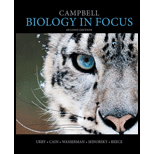
Concept explainers
In what way do the membranes of a eukaryotic cell vary?
- A. Phospholipids are found only in certain membranes.
- B. Certain proteins are unique to each kind of membrane.
- C. Only certain membranes of the cell are selectively permeable.
- D. Only certain membranes are constructed from amphipathic molecules.
Introduction:
The lipid bilayer model of the membrane consists of proteins and lipids with triacylglycerols. This structure maintains the fluidity of membrane. Various phospholipids are present in the membrane. They consist of a hydrophilic head and a hydrophobic tail. The presence of the lipid cholesterol provides flexibility to the membrane at various temperatures. Various unique proteins are present in the membrane like cell signaling proteins and growth receptors.
Answer to Problem 1TYU
Correct answer:
The membrane is unique and consists of lipids and proteins. The proteins present in the membrane are specific and form an essential part of cell signaling and growth receptor signaling response. Therefore, option (B) is correct.
Explanation of Solution
Reason for the correct statement:
The membrane of the cells contains unique proteins. The proteins are present in the membrane are specific and help in the signaling inside the cells by the activation of the protein growth factor receptors.
Option (B) is given as “Certain proteins are unique to each kind of membrane”.
As, “the proteins present in the membrane of a eukaryotic cell are unique and perform specific functions according to the type of proteins present in the cell”, it is the right answer.
Hence, option (B) is correct.
Reasons for the incorrect statements:
Option (A) is given as “Phospholipids are found only in certain membranes”. Phospholipids are present in the membranes, but the proteins present in the membrane are unique, specific and diverse. So, it is the wrong answer.
Option (C) is given as “Only certain membranes of the cell are selectively permeable”. The cell membranes are selectively permeable to the movement of the various solutes like glucose and ions, which cross the membrane across the protein channels. They are unique and specific to the membrane. So, it is a wrong answer.
Option (D) is given as “Only certain membranes are constructed from amphipathic molecules”.
The membrane molecules are amphipathic, but the proteins formed in the membrane are specific and unique. So, it is a wrong answer.
Hence, options (A), (C), and (D) are incorrect.
The proteins present in the membrane are unique, specific and are of various types. These include the cell signaling proteins, growth factor receptor proteins, post-translationally modified proteins, blood group proteins, and cluster of differentiation receptor proteins.
Want to see more full solutions like this?
Chapter 5 Solutions
Campbell Biology in Focus (2nd Edition)
Additional Science Textbook Solutions
Chemistry: Structure and Properties (2nd Edition)
Campbell Biology: Concepts & Connections (9th Edition)
Chemistry: An Introduction to General, Organic, and Biological Chemistry (13th Edition)
Cosmic Perspective Fundamentals
Microbiology with Diseases by Body System (5th Edition)
Chemistry & Chemical Reactivity
- Not part of a graded assignment, from a past midtermarrow_forwardNoggin mutation: The mouse, one of the phenotypic consequences of Noggin mutationis mispatterning of the spinal cord, in the posterior region of the mouse embryo, suchthat in the hindlimb region the more ventral fates are lost, and the dorsal Pax3 domain isexpanded. (this experiment is not in the lectures).a. Hypothesis for why: What would be your hypothesis for why the ventral fatesare lost and dorsal fates expanded? Include in your answer the words notochord,BMP, SHH and either (or both of) surface ectoderm or lateral plate mesodermarrow_forwardNot part of a graded assignment, from a past midtermarrow_forward
- Explain in a flowcharts organazing the words down below: genetics Chromosomes Inheritance DNA & Genes Mutations Proteinsarrow_forwardplease helparrow_forwardWhat does the heavy dark line along collecting duct tell us about water reabsorption in this individual at this time? What does the heavy dark line along collecting duct tell us about ADH secretion in this individual at this time?arrow_forward
 Concepts of BiologyBiologyISBN:9781938168116Author:Samantha Fowler, Rebecca Roush, James WisePublisher:OpenStax College
Concepts of BiologyBiologyISBN:9781938168116Author:Samantha Fowler, Rebecca Roush, James WisePublisher:OpenStax College Biology Today and Tomorrow without Physiology (Mi...BiologyISBN:9781305117396Author:Cecie Starr, Christine Evers, Lisa StarrPublisher:Cengage Learning
Biology Today and Tomorrow without Physiology (Mi...BiologyISBN:9781305117396Author:Cecie Starr, Christine Evers, Lisa StarrPublisher:Cengage Learning
 Biology (MindTap Course List)BiologyISBN:9781337392938Author:Eldra Solomon, Charles Martin, Diana W. Martin, Linda R. BergPublisher:Cengage Learning
Biology (MindTap Course List)BiologyISBN:9781337392938Author:Eldra Solomon, Charles Martin, Diana W. Martin, Linda R. BergPublisher:Cengage Learning





